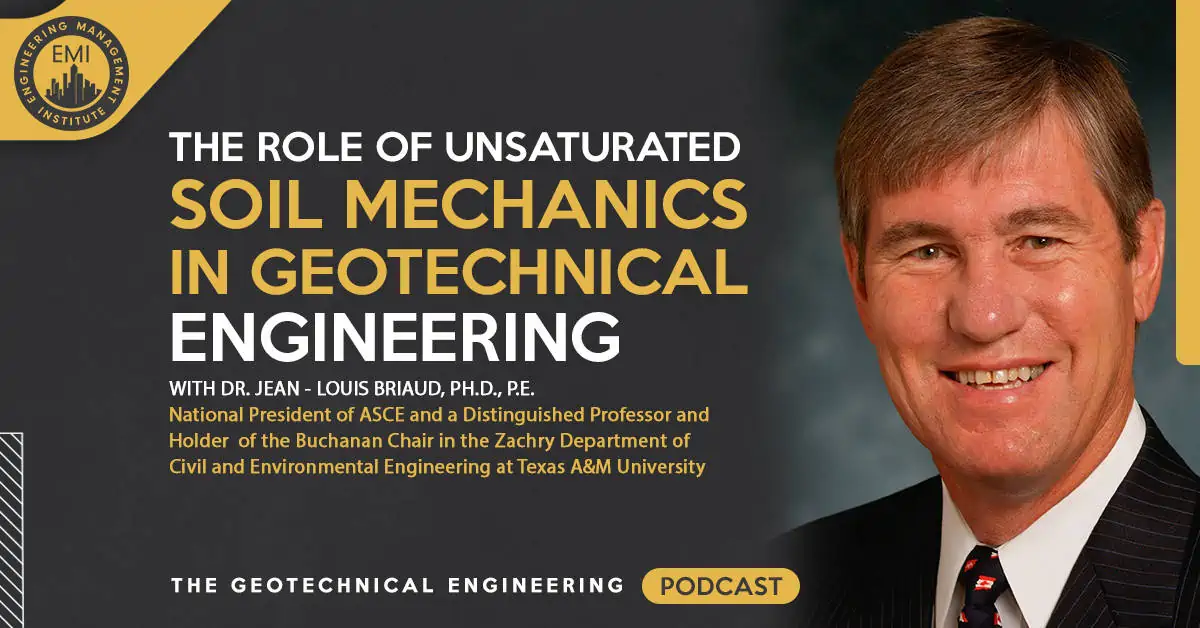Podcast: Play in new window | Download | Embed
In this episode, we talk to Dr. Jean-Louis Briaud, Ph.D., P.E., the National President of ASCE and a Distinguished Professor and Holder of the Buchanan Chair in the Zachry Department of Civil and Environmental Engineering at Texas A&M University, about unsaturated soil mechanics.
Engineering Quotes:
Here Are Some of the Questions We Ask Dr. Jean–Louis Briaud, Ph.D., P.E.:
- How can your book, “Geotechnical Engineering: Unsaturated and Saturated Soils,” benefit geotechnical engineers as well as college students?
- What are unsaturated soils?
- How can we use unsaturated soil mechanics in practice?
- Is staying curious as a geotechnical engineer important?
- In your opinion, should we teach unsaturated soil mechanics to undergraduate students, and if so, why?
- Looking back at the earlier research of unsaturated soils, was it seen as uncontroversial?
- What excites you about the future of geotechnical engineering?
Here Are Some of the Key Points Discussed About Saturated and Unsaturated Soils:
- The book, “Geotechnical Engineering: Unsaturated and Saturated Soils,” can benefit geotechnical engineers as well as college students because it explains things in a way that is easier to understand by everyone. It also contains most of the important information about unsaturated and saturated soils. It can make the job of the educators and professors a lot simpler when it comes to preparing for their lectures on this subject. Geotechnical engineers can use the book to implement saturated and unsaturated soil mechanics in everyday practice.
- Unsaturated soils are the soils that are above the water level. The soils above the water level can still be saturated because the water is in tension and being sucked up into the pores of the soil. The water tension can pull up the water to tremendous heights above the water level. The zone of soil that is above this height is truly unsaturated, where there is air and water in the soil pores. The tension that is above the water level increases the strength of the materials. It is good to have something that is stronger to build on, but this strength needs to be present throughout the year. Fluctuations in the water level can cause the water tension to diminish, which results in a decrease in strength of the materials. You ultimately need to determine if you can count on the strengths of the materials for the lifetime of the structure.
- Unsaturated soils also mean soils that have water in them, but it is under tension. We can then apply unsaturated soil mechanics to this saturated soil because the water is in tension. This needs to be considered because many problems that geotechnical engineers face are in the zone above the water table.
- Research in saturated and unsaturated soils is tremendously important for young professors. The industry should talk to the younger professors about what is important. This interaction is essential because the young professors have tremendous energy, desire, and motivation to work on the research problems.
- If you look at recent transportation history, 1,000 years ago we were using horses, and 100 years ago we were still using horses. There has been a technological explosion since then, and now we have cars, planes, and even space rockets. It is an extremely exciting time to be in engineering.
- Unsaturated soils should be taught from the undergraduate level. The study of unsaturated soils has been around for over 50 years, which puts us in the position to be able to teach the basic concepts to undergraduate levels, but the teachings need to be made simple and interesting.
- In earlier research, the phenomenon of saturated and unsaturated soils was obvious and seen as something that must be addressed. There was controversy back then, and even today surrounding this research. Controversy should be made up of professional disagreements, which is the best way to arrive at a solution that builds consensus.
- Geotechnical engineering is exciting because it is a very diversified field. It is as much work in the office as it is in the field. There is a tremendous challenge in geotechnical engineering and the materials are complicated. It is going to be exciting to design our projects based on risk factors and need to put the value of the consequence into our decision process.
More Details in This Episode…
About Dr. Jean–Louis Briaud, Ph.D., P.E.

Books Mentioned in This Episode:
Geotechnical Engineering: Unsaturated and Saturated Soils
Sources/References:
Texas A&M University
Zachry Department of Civil and Environmental Engineering
Connect with Dr. Jean-Louis Briaud on LinkedIn
Please leave your comments or questions in the section below on the role of unsaturated soil mechanics in geotechnical engineering.
To your success,
Jared M. Green, P.E., D. GE, NOMA
Host of The Geotechnical Engineering Podcast







